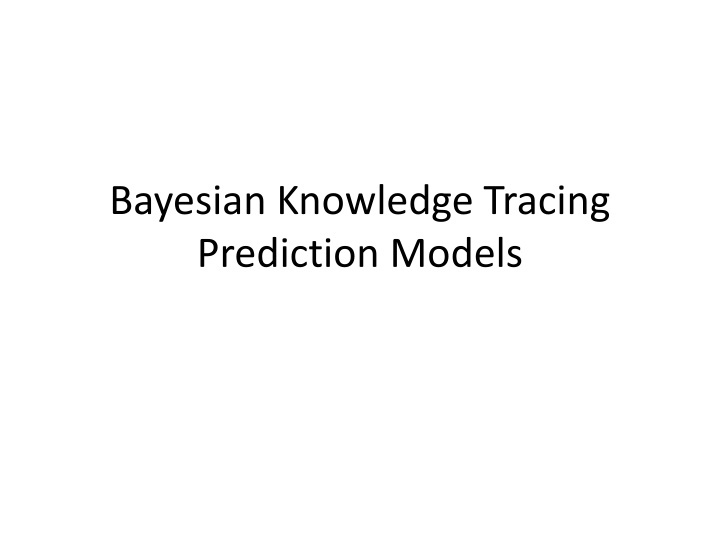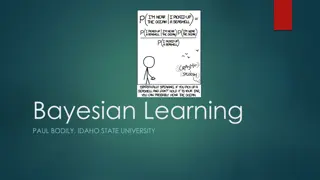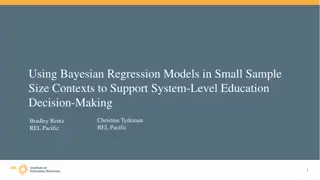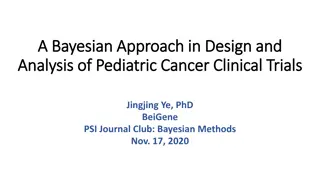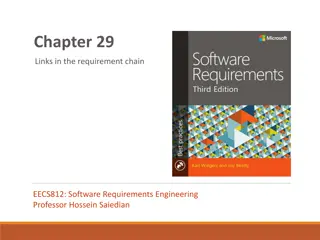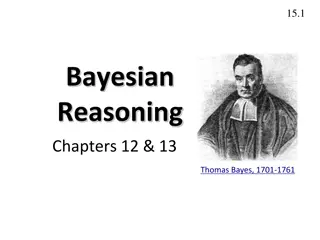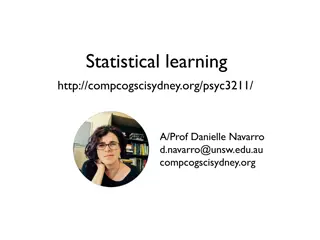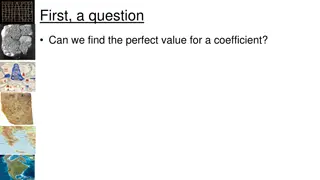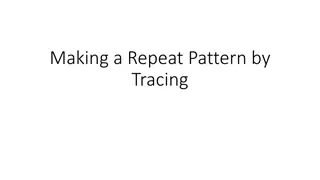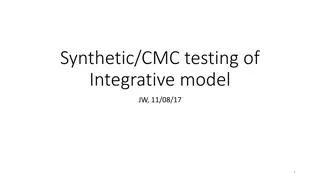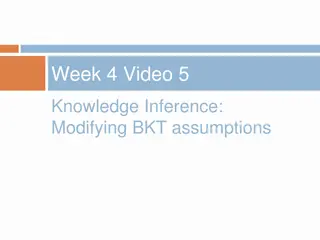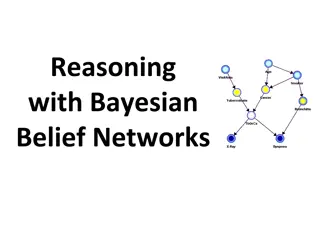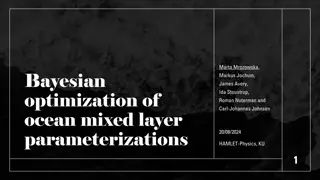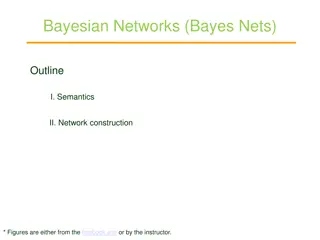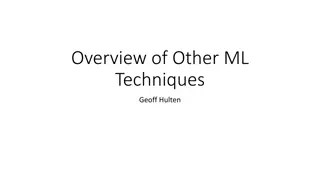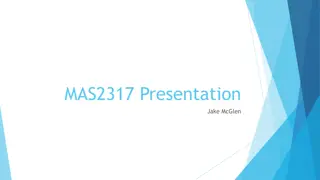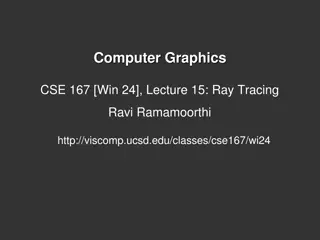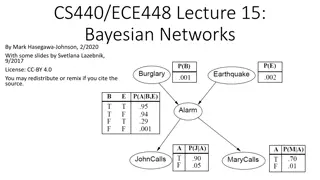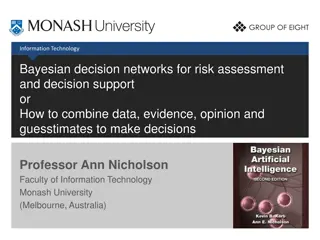Bayesian Knowledge Tracing Prediction Models
In Bayesian Knowledge Tracing, the goal is to infer a student's knowledge state from their responses. The model predicts future correctness and assesses student behavior based on skills and knowledge components. Assumptions include mapping correct responses to skills accurately. Explore Bayesian Knowledge Tracing further with insights on handling multiple skills and primary skill per step.
Uploaded on Feb 26, 2025 | 0 Views
Download Presentation

Please find below an Image/Link to download the presentation.
The content on the website is provided AS IS for your information and personal use only. It may not be sold, licensed, or shared on other websites without obtaining consent from the author.If you encounter any issues during the download, it is possible that the publisher has removed the file from their server.
You are allowed to download the files provided on this website for personal or commercial use, subject to the condition that they are used lawfully. All files are the property of their respective owners.
The content on the website is provided AS IS for your information and personal use only. It may not be sold, licensed, or shared on other websites without obtaining consent from the author.
E N D
Presentation Transcript
Bayesian Knowledge Tracing Prediction Models
Goal Infer the latent construct Does a student know skill X
Goal Infer the latent construct Does a student know skill X From their pattern of correct and incorrect responses on problems or problem steps involving skill X
Enabling Prediction of future correctness within the educational software Prediction of future correctness outside the educational software e.g. on a post-test
Assumptions Student behavior can be assessed as correct or not correct Each problem step/problem is associated with one skill/knowledge component
Assumptions Student behavior can be assessed as correct or not correct Each problem step/problem is associated with one skill/knowledge component And this mapping is defined reasonably accurately
Assumptions Student behavior can be assessed as correct or not correct Each problem step/problem is associated with one skill/knowledge component And this mapping is defined reasonably accurately (though extensions such as Contextual Guess and Slip may be robust to violation of this constraint)
Multiple skills on one step There are alternate approaches which can handle this (cf. Conati, Gertner, & VanLehn, 2002; Ayers & Junker, 2006; Pardos, Beck, Ruiz, & Heffernan, 2008) Bayesian Knowledge-Tracing is simpler (and should produce comparable performance) when there is one primary skill per step
Bayesian Knowledge Tracing Goal: For each knowledge component (KC), infer the student s knowledge state from performance. Suppose a student has six opportunities to apply a KC and makes the following sequence of correct (1) and incorrect (0) responses. Has the student has learned the rule? 0 0 1 0 1 1
Model Learning Assumptions Two-state learning model Each skill is either learned or unlearned In problem-solving, the student can learn a skill at each opportunity to apply the skill A student does not forget a skill, once he or she knows it Studied in Pavlik s models Only one skill per action
Addressing Noise and Error If the student knows a skill, there is still some chance the student will slip and make a mistake. If the student does not know a skill, there is still some chance the student will guess correctly.
Corbett and Andersons Model p(T) Not learned Learned p(L0) p(G) 1-p(S) correct correct Two Learning Parameters p(L0) problem solving. Probability the skill is already known before the first opportunity to use the skill in p(T) Probability the skill will be learned at each opportunity to use the skill. Two Performance Parameters p(G) Probability the student will guess correctly if the skill is not known. p(S) Probability the student will slip (make a mistake) if the skill is known.
Bayesian Knowledge Tracing Whenever the student has an opportunity to use a skill, the probability that the student knows the skill is updated using formulas derived from Bayes Theorem.
Knowledge Tracing How do we know if a knowledge tracing model is any good? Our primary goal is to predict knowledge
Knowledge Tracing How do we know if a knowledge tracing model is any good? Our primary goal is to predict knowledge But knowledge is a latent trait
Knowledge Tracing How do we know if a knowledge tracing model is any good? Our primary goal is to predict knowledge But knowledge is a latent trait We can check our knowledge predictions by checking how well the model predicts performance
Fitting a Knowledge-Tracing Model In principle, any set of four parameters can be used by knowledge-tracing But parameters that predict student performance better are preferred
Knowledge Tracing So, we pick the knowledge tracing parameters that best predict performance Defined as whether a student s action will be correct or wrong at a given time Effectively a classifier (which we ll talk about in a few minutes)
Recent Extensions Recently, there has been work towards contextualizing the guess and slip parameters (Baker, Corbett, & Aleven, 2008a, 2008b) Do we really think the chance that an incorrect response was a slip is equal when Student has never gotten action right; spends 78 seconds thinking; answers; gets it wrong Student has gotten action right 3 times in a row; spends 1.2 seconds thinking; answers; gets it wrong
The jurys still out Initial reports showed that CG BKT predicted performance in the tutor much better than existing approaches to fitting BKT (Baker, Corbett, & Aleven, 2008a, 2008b) But a new brute force approach, which tries all possible parameter values for the 4-parameter model performs equally well as CG BKT (Baker, Corbett, Gowda, 2010)
The jurys still out CG BKT predicts post-test performance worse than existing approaches to fitting BKT (Baker, Corbett, Gowda, et al, 2010) But P(S) predicts post-test above and beyond BKT (Baker, Corbett, Gowda, et al, 2010) So there is some way that contextual G and S are useful we just don t know what it is yet
Fitting BKT models Bayes Net Toolkit Student Modeling Expectation Maximization http://www.cs.cmu.edu/~listen/BNT-SM/ Java Code Grid Search/Brute Force http://users.wpi.edu/~rsbaker/edmtools.html Conflicting results as to which is best
Identifiability Different models can achieve the same predictive power (Beck & Chang, 2007; Pardos et al, 2010)
Model Degeneracy Some model parameter values, typically where P(S) or P(G) is greater than 0.5 Infer that knowledge leads to poorer performance (Baker, Corbett, & Aleven, 2008)
Bounding Corbett & Anderson (1995) bounded P(S) and P(G) to maximum values below 0.5 to avoid this P(S)<0.1 P(G)<0.3 Fancier approaches have not yet solved this problem in a way that clearly avoids model degeneracy
Uses of Knowledge Tracing Often key components in models of other constructs Help-Seeking and Metacognition (Aleven et al, 2004, 2008) Gaming the System (Baker et al, 2004, 2008) Off-Task Behavior (Baker, 2007)
Uses of Knowledge Tracing If you want to understand a student s strategic/meta-cognitive choices, it is helpful to know whether the student knew the skill Gaming the system means something different if a student already knows the step, versus if the student doesn t know it A student who doesn t know a skill should ask for help; a student who does, shouldn t
Cognitive Mastery One way that Bayesian Knowledge Tracing is frequently used is to drive Cognitive Mastery Learning (Corbett & Anderson, 2001) Essentially, a student is given more practice on a skill until P(Ln)>=0.95 Note that other skills are often interspersed
Cognitive Mastery Leads to comparable learning in less time Over-practice continuing after mastery has been reached does not lead to better post- test performance (cf. Cen, Koedinger, & Junker, 2006) Though it may lead to greater speed and fluency (Pavlik et al, 2008)
Prediction: Classification and Regression
Prediction Pretty much what it says A student is using a tutor right now. Is he gaming the system or not? A student has used the tutor for the last half hour. How likely is it that she knows the skill in the next step? A student has completed three years of high school. What will be her score on the college entrance exam?
Classification General Idea Canonical Methods Assessment Ways to do assessment wrong
Classification There is something you want to predict ( the label ) The thing you want to predict is categorical The answer is one of a set of categories, not a number CORRECT/WRONG (sometimes expressed as 0,1) HELP REQUEST/WORKED EXAMPLE REQUEST/ATTEMPT TO SOLVE WILL DROP OUT/WON T DROP OUT WILL SELECT PROBLEM A,B,C,D,E,F, or G
Classification Associated with each label are a set of features , which maybe you can use to predict the label Skill ENTERINGGIVEN ENTERINGGIVEN USEDIFFNUM ENTERINGGIVEN REMOVECOEFF REMOVECOEFF USEDIFFNUM . pknow 0.704 0.502 0.049 0.967 0.792 0.792 0.073 time 9 10 6 7 16 13 5 totalactions 1 2 1 3 1 2 2 right WRONG RIGHT WRONG RIGHT WRONG RIGHT RIGHT
Classification The basic idea of a classifier is to determine which features, in which combination, can predict the label Skill ENTERINGGIVEN ENTERINGGIVEN USEDIFFNUM ENTERINGGIVEN REMOVECOEFF REMOVECOEFF USEDIFFNUM . pknow 0.704 0.502 0.049 0.967 0.792 0.792 0.073 time 9 10 6 7 16 13 5 totalactions 1 2 1 3 1 2 2 right WRONG RIGHT WRONG RIGHT WRONG RIGHT RIGHT
Classification One way to classify is with a Decision Tree (like J48) PKNOW <0.5 >=0.5 TIME TOTALACTIONS <6s. >=6s. <4 >=4 RIGHT WRONG RIGHT WRONG
Classification One way to classify is with a Decision Tree (like J48) PKNOW <0.5 >=0.5 TIME TOTALACTIONS <6s. >=6s. <4 >=4 RIGHT WRONG RIGHT WRONG Skill COMPUTESLOPE pknow 0.544 time 9 totalactions 1 right ?
Classification Another way to classify is with step regression (used in Cetintas et al, 2009; Baker, Mitrovic, & Mathews, 2010) Linear regression (discussed later), with a cut- off
And of course There are lots of other classification algorithms you can use... SMO (support vector machine) In your favorite Machine Learning package
How can you tell if a classifier is any good?
How can you tell if a classifier is any good? What about accuracy? # correct classifications total number of classifications 9200 actions were classified correctly, out of 10000 actions = 92% accuracy, and we declare victory.
How can you tell if a classifier is any good? What about accuracy? # correct classifications total number of classifications 9200 actions were classified correctly, out of 10000 actions = 92% accuracy, and we declare victory. Any issues?
Non-even assignment to categories Percent Agreement does poorly when there is non-even assignment to categories Which is almost always the case Imagine an extreme case Uniqua (correctly) picks category A 92% of the time Tasha always picks category A Agreement/accuracy of 92% But essentially no information
What are some alternate metrics you could use?
